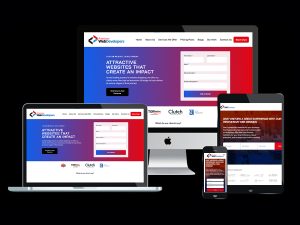Mistakes to Avoid when creating Personalized Websites
Mistakes to Avoid when creating Personalized Websites

It’s no secret that most money businesses make nowadays comes from online websites. They are now becoming the storefronts of today, and this trend is expected to continue. Just as shops want unique signage and storefronts, brands want personalized websites to distinguish themselves.
However, it’s easy to make mistakes in a rush to create the next best site. The overzealous expansion has a way of harming your brand image. To help you, we found a few common mistakes entrepreneurs make when creating their own sites. Stick around till the end, and we’ll share some best practices. We’ll also point you in the right direction for web development.
Personalized Websites – What Do They Accomplish?
Personalised websites allow brands to connect to customers like never before. They are different from conventional websites. A far cry from templates. Rather, they rely on user-friendliness, creativity, and innovation to build the user experience. Unfortunately, with so much riding on them, these sites are often under a lot of pressure to succeed.
Building a website is similar to building a brand. You have to make strategic decisions and slowly create your own niche in the market. Many people think websites are a “get-rich-quick” scheme. That can’t be further from the truth. The truth is that managing a site is hard work.
Making sure your site generates the returns you want requires a strategy. If you lack a thorough and robust strategy, you might fall victim to the mistakes we’ll discuss. So, it is important to be prepared to avoid these pitfalls when developing personalised websites.
Here Are Some Common Mistakes To Avoid
Without further ado, let’s see what mistakes people make and how it costs them. Here they are.
No Mobile Integration
This is key for many websites in the modern day. People browse the internet more through their phones and less through desktops. This necessitates websites to adapt and provide mobile integration. Unfortunately, not all get the memo, and customers are left with a site that barely works on phones.
It isn’t enough to build a functioning and compatible interface, though. An inconsistent mobile version made hastily can confuse customers and draw them away. Moreover, mobile browsing is the reality of today’s internet; thus, mobile integration is key.
Confusing Interface
Personalized websites seek to distinguish themselves from the rest. That’s all well and good, but at what cost? If your uniqueness comes at the cost of user experience, you’re doing it wrong. Many websites try to make themselves overly complicated so as to be different. That rarely works.
Confusing interfaces can make people click off and never revisit. If the site isn’t user-friendly, then customers will find one that is. Navigation is a key aspect that people misunderstand. Customers shouldn’t have to sift through menus to get to the checkout page.
Slow Load Times
Your customized site probably has animations and images. Perhaps videos are there too. Now ask yourself, “Is it necessary?” Adding multimedia is great, but you have to leverage it next to the cost. Loading all of the media on the page takes time to load. As such, ensure they don’t take too long, or customers will click off.
On the internet, you compete with millions of other sites for the customers’ attention. There are only 24 hours in a day, and people want to spend them wisely. As such, they won’t wait around for more than a few seconds for your site. It doesn’t matter how fancy the graphics are. Time management takes the cake. At least in a general scenario.
Bad SEO Practices
Search Engine Optimization is a very complicated beast and is easy to get wrong. Google’s guidelines are updated regularly, and any web developer must review them frequently. Bad SEO practices can make your site lose visitors and ranking in search results, so beware.
Overstuffing keywords, improper paragraph lengths, plagiarism, and other things are all being phased out. Sites that persist in these bad SEO practices are forced to adapt or go out of business. Don’t take the easy way out regarding content and off-page SEO. It can cost you.
Lack of Uniqueness
What’s the point of custom-made websites if you don’t push them to the limits? So many people jump on the craze for unique sites. However, they tend to play it safe when they get to the nitty gritty of things. Instead of indulging in creativity, they model their site after other successful websites.
This robs the essence of any unique website. While safe, this approach offers little in terms of benefits and ROI. If you are going down the route of unique sites, it is better to go all-in and rely on your creativity.
Here’s What You Should Do Instead
Personalized Websites need Personalized Strategies
When creating a site, you need to rely on development strategies. These can give you a map of your site and make it easier to keep the focus on what matters. Everything on your site must be strategically placed.
A strategic plan outlines all the efforts and goals of the site. It will help you minimize costs and increase efficiency. Furthermore, establishing a plan can allow you to make room for additional utilities and technological advancements.
Proper Content Management
Goal oriented websites put content management at the forefront. Content management means ensuring that customers find what they are looking for. That means no clickbait, good readability, and proper SEO practices.
Making sure you follow these practices is essential to a good user experience. People visit sites to gather information. The information should, of course, be readily available. This requires a content management strategy, so make one now.
Minimalism and Brevity
Overburdening the visitors is strictly unadvised. Avoid front-loading your pages. Not only will it lead to reduced load times, but it will also help in building customer engagement. Minimalism is a common trend today for a good reason.
Brevity in design and content can help customers feel more relaxed. Moreover, it gives an appealing look. So try to use a few words and pictures to say a lot. That is the philosophy behind minimalism.
Mobile Integration
As we mentioned, people prefer browsing on mobile phones these days while on the go. That’s why sites need to be compatible with phones and tablets. Ensure compatibility by using web development tools.
Furthermore, keep the theme consistent. However, make changes when necessary. For example, resizing the text and doing away with paragraphs is good practice. Anything to make the site browsable on mobile phones needs to be done.
Digital Marketing
A website needs a steady stream of visitors to keep it running. Of course, you might not have enough customers when starting out, and that’s to be expected. However, you can exponentially increase your customers through digital marketing.
Digital marketing involves promoting your website on social media and through advertisements on the internet. It is proven to raise customer awareness and drive them toward your site. The more engaging your marketing campaigns, the more customers will be curious to see what you’re all about.
The Ball’s in Your Court Now!
Now that you know the dos and don’ts, we feel you might be more comfortable moving forward. It’s up to you now to decide how to create your site. If you need help creating personalized websites, contact American Web Developers. Their team of experienced designers can definitely be a great help in avoiding these mistakes.



